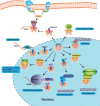ERH Gene and Its Role in Cancer Cells
- PMID: 35677162
- PMCID: PMC9169799
- DOI: 10.3389/fonc.2022.900496
ERH Gene and Its Role in Cancer Cells
Abstract
Cancer is a major public health problem worldwide. Studies on oncogenes and tumor-targeted therapies have become an important part of cancer treatment development. In this review, we summarize and systematically introduce the gene enhancer of rudimentary homolog (ERH), which encodes a highly conserved small molecule protein. ERH mainly exists as a protein partner in human cells. It is involved in pyrimidine metabolism and protein complexes, acts as a transcriptional repressor, and participates in cell cycle regulation. Moreover, it is involved in DNA damage repair, mRNA splicing, the process of microRNA hairpins as well as erythroid differentiation. There are many related studies on the role of ERH in cancer cells; however, there are none on tumor-targeted therapeutic drugs or related therapies based on the expression of ERH. This study will provide possible directions for oncologists to further their research studies in this field.
Keywords: enhancer of rudimentary homolog (ERH) gene; oncogenesis factor; protein partner; transcription factor; tumor-targeted therapy.
Copyright © 2022 Pang, Li, Hao, Shi, Feng, Chen, Ma, Xu, Pan, Chen and Han.
Conflict of interest statement
The authors declare that the research was conducted in the absence of any commercial or financial relationships that could be construed as a potential conflict of interest.
Figures



Similar articles
-
Drosophila Enhancer of Rudimentary Homolog, ERH, Is a Binding Partner of RPS3, RPL19, and DDIT4, Suggesting a Mechanism for the Nuclear Localization of ERH.Mol Biol Int. 2016;2016:8371819. doi: 10.1155/2016/8371819. Epub 2016 Oct 18. Mol Biol Int. 2016. PMID: 27830090 Free PMC article.
-
Knockdown of enhancer of rudimentary homolog inhibits proliferation and metastasis in ovarian cancer by regulating epithelial-mesenchymal transition.Biomed Pharmacother. 2020 May;125:109974. doi: 10.1016/j.biopha.2020.109974. Epub 2020 Feb 7. Biomed Pharmacother. 2020. PMID: 32036222
-
Crystal structure of an enhancer of rudimentary homolog (ERH) at 2.1 Angstroms resolution.Protein Sci. 2005 Jul;14(7):1888-93. doi: 10.1110/ps.051484505. Epub 2005 Jun 3. Protein Sci. 2005. PMID: 15937287 Free PMC article.
-
The enigmatic ERH protein: its role in cell cycle, RNA splicing and cancer.Protein Cell. 2013 Nov;4(11):807-12. doi: 10.1007/s13238-013-3056-3. Protein Cell. 2013. PMID: 24078386 Free PMC article. Review.
-
Effects of bioactive components of Pu-erh tea on gut microbiomes and health: A review.Food Chem. 2021 Aug 15;353:129439. doi: 10.1016/j.foodchem.2021.129439. Epub 2021 Mar 3. Food Chem. 2021. PMID: 33743430 Review.
Cited by
-
Epigenetic dysregulated long non-coding RNAs in renal cell carcinoma based on multi-omics data and their influence on target drugs sensibility.Front Genet. 2024 Aug 2;15:1406150. doi: 10.3389/fgene.2024.1406150. eCollection 2024. Front Genet. 2024. PMID: 39156959 Free PMC article.
-
Impact of Asp/Glu-ADP-ribosylation on protein-protein interaction and protein function.Proteomics. 2023 Sep;23(17):e2200083. doi: 10.1002/pmic.202200083. Epub 2022 Dec 11. Proteomics. 2023. PMID: 36453556 Free PMC article.
-
ERH Impacts Patient Prognosis and Tumor Immune Microenvironment: A Pan-Cancer Analysis.Comb Chem High Throughput Screen. 2025;28(5):853-871. doi: 10.2174/0113862073295696240322084341. Comb Chem High Throughput Screen. 2025. PMID: 38584561
-
Upregulated enhancer of rudimentary homolog promotes epithelial‑mesenchymal transition and cancer cell migration in lung adenocarcinoma.Mol Med Rep. 2024 Jan;29(1):9. doi: 10.3892/mmr.2023.13132. Epub 2023 Nov 24. Mol Med Rep. 2024. PMID: 37997813 Free PMC article.
-
ERH promotes primary microRNA processing beyond cluster assistance.Nat Commun. 2025 Aug 25;16(1):7913. doi: 10.1038/s41467-025-63015-y. Nat Commun. 2025. PMID: 40854975 Free PMC article.
References
-
- Danesi R, Fogli S, Indraccolo S, Del Re M, Dei Tos AP, Leoncini L, et al. . Druggable Targets Meet Oncogenic Drivers: Opportunities and Limitations of Target-Based Classification of Tumors and the Role of Molecular Tumor Boards. ESMO Open (2021) 6:100040. doi: 10.1016/j.esmoop.2020.100040 - DOI - PMC - PubMed
Publication types
LinkOut - more resources
Full Text Sources

